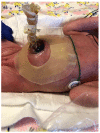Gastroschisis: A State-of-the-Art Review
- PMID: 33348575
- PMCID: PMC7765881
- DOI: 10.3390/children7120302
Gastroschisis: A State-of-the-Art Review
Abstract
Gastroschisis, the most common type of abdominal wall defect, has seen a steady increase in its prevalence over the past several decades. It is identified, both prenatally and postnatally, by the location of the defect, most often to the right of a normally-inserted umbilical cord. It disproportionately affects young mothers, and appears to be associated with environmental factors. However, the contribution of genetic factors to the overall risk remains unknown. While approximately 10% of infants with gastroschisis have intestinal atresia, extraintestinal anomalies are rare. Prenatal ultrasound scans are useful for early diagnosis and identification of features that predict a high likelihood of associated bowel atresia. The timing and mode of delivery for mothers with fetuses with gastroschisis have been somewhat controversial, but there is no convincing evidence to support routine preterm delivery or elective cesarean section in the absence of obstetric indications. Postnatal surgical management is dictated by the condition of the bowel and the abdominal domain. The surgical options include either primary reduction and closure or staged reduction with placement of a silo followed by delayed closure. The overall prognosis for infants with gastroschisis, in terms of both survival as well as long-term outcomes, is excellent. However, the management and outcomes of a subset of infants with complex gastroschisis, especially those who develop short bowel syndrome (SBS), remains challenging. Future research should be directed towards identification of epidemiological factors contributing to its rising incidence, improvement in the management of SBS, and obstetric/fetal interventions to minimize intestinal damage.
Keywords: abdominal defect; congenital anomaly; infant; newborn; nutrition.
Conflict of interest statement
The authors declare no conflict of interest.
Figures





Similar articles
-
[New surgical strategy in gastroschisis: treatment simplification according to its physiopathology].Cir Pediatr. 2005 Oct;18(4):182-7. Cir Pediatr. 2005. PMID: 16466144 Spanish.
-
The association between gestational age at delivery, closure type and perinatal outcomes in neonates with isolated gastroschisis.J Matern Fetal Neonatal Med. 2020 Apr;33(8):1393-1399. doi: 10.1080/14767058.2018.1519538. Epub 2018 Oct 1. J Matern Fetal Neonatal Med. 2020. PMID: 30173575
-
Gastroschisis: A Review of Management and Outcomes.Obstet Gynecol Surv. 2016 Sep;71(9):537-44. doi: 10.1097/OGX.0000000000000344. Obstet Gynecol Surv. 2016. PMID: 27640608 Review.
-
Neonatal abdominal wall defects.Semin Fetal Neonatal Med. 2011 Jun;16(3):164-72. doi: 10.1016/j.siny.2011.02.003. Epub 2011 Apr 6. Semin Fetal Neonatal Med. 2011. PMID: 21474399 Review.
-
Outcomes in infants with prenatally diagnosed gastroschisis and planned preterm delivery.Pediatr Surg Int. 2015 Nov;31(11):1047-53. doi: 10.1007/s00383-015-3795-8. Epub 2015 Sep 23. Pediatr Surg Int. 2015. PMID: 26399421
Cited by
-
An Unusual Combination of Arthrogryposis, Gastroschisis, Cecal Volvulus, and Malignant Hyperthermia in a Young Woman: A Case Report.Am J Case Rep. 2023 Jan 13;24:e938031. doi: 10.12659/AJCR.938031. Am J Case Rep. 2023. PMID: 36635941 Free PMC article.
-
Ultrasound Markers for Complex Gastroschisis: A Systematic Review and Meta-Analysis.J Clin Med. 2021 Nov 9;10(22):5215. doi: 10.3390/jcm10225215. J Clin Med. 2021. PMID: 34830497 Free PMC article. Review.
-
Ratio between Abdominal Defect Size and Abdominal Circumference Measured Preoperatively May Predict Type of Closure in Neonates with Gastroschisis.J Indian Assoc Pediatr Surg. 2025 Mar-Apr;30(2):170-176. doi: 10.4103/jiaps.jiaps_154_24. Epub 2025 Mar 3. J Indian Assoc Pediatr Surg. 2025. PMID: 40191487 Free PMC article.
-
Comparison of total prevalence, perinatal prevalence, and livebirth prevalence of birth defects in Hunan Province, China, 2016-2020.Front Public Health. 2024 Sep 11;12:1297426. doi: 10.3389/fpubh.2024.1297426. eCollection 2024. Front Public Health. 2024. PMID: 39324160 Free PMC article.
-
Gastroschisis prevalence patterns in 27 surveillance programs from 24 countries, International Clearinghouse for Birth Defects Surveillance and Research, 1980-2017.Birth Defects Res. 2024 Feb;116(2):e2306. doi: 10.1002/bdr2.2306. Birth Defects Res. 2024. PMID: 38411327 Free PMC article.
References
-
- Moore T.C., Stokes G.E. Gastroschisis; Report of two cases treated by a modification of the gross operation for omphalocele. Surgery. 1953;33:112–120. - PubMed
-
- International Clearinghouse for Birth Defects Surveillance and Research Annual Report 2014. International Centre on Birth Defects (ICBDSR Centre), Rome, Italy. [(accessed on 4 August 2020)]; Available online: http://www.icbdsr.org/wp-content/annual_report/Report2014.pdf.
Publication types
Grants and funding
LinkOut - more resources
Full Text Sources
Miscellaneous

